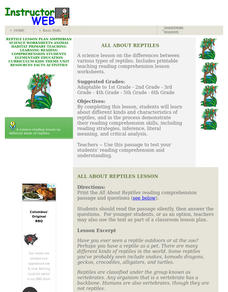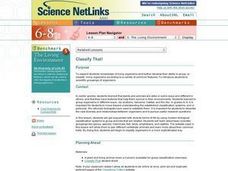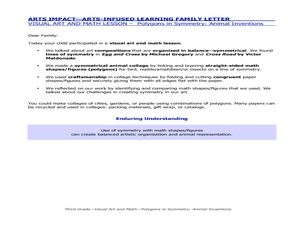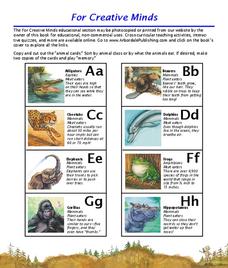Curated OER
All About Reptiles
Students examine different kinds and characteristics of reptiles, and demonstrate reading comprehension skills, including reading strategies, inference, literal meaning, and critical analysis.
Curated OER
Animals
Students become familiar with the need for categorizing scientific information, in this case, animals. They categorize the 5 groups of animals in a collage and answer questions about each.
Curated OER
Searching the Digital Atlas
Students become familiar with the tools of a digital atlas. They use a digital atlas of Idaho to located specified information. Students identify national forests, locate butterfly families, find examples of resident fish, and explore...
Curated OER
Classify That!
Students explore diverse forms of life by using modern biological classification systems to group animals that are related. Students then study basic scientific groupings like genus, species, mammals, fish, birds, amphibians, and...
Curated OER
Herps and Humans
Students compare and contrast the similarities and differences between the internal organs of herps--reptiles and amphibians--and humans.
Curated OER
Polygons in Symmetry: Animal Inventions
Fourth graders use polygons to create animal figures with symmetry. In this polygons and symmetry lesson, 4th graders create a symmetrical animal collage by cutting and gluing geometric shapes and figures from math activities.
Curated OER
Elementary Animal Classification
Students investigate eight basic animal groups, and identify the different groups through knowledge of animal characteristics, changes, and life cycles of each group.
Curated OER
Mammals Have Fur
First graders study animals. In this animal classification instructional activity, 1st graders explore the characteristics (primarily fur) that distinguish animals as mammals. They work in groups at various stations that practice this...
Curated OER
What's Your Classification
Young scholars classify animals. In this animal groups lesson plan, students watch a video on animal groups and review the six animal groups. Young scholars practice classifying animals using stuffed animals.
Curated OER
The Census of Marine Life
Students explain diversity and abundance in marine life. For this oceanic biology lesson, students collect information for various geographical areas to collect a census of marine life.
Curated OER
An Egg is Quiet
Students discover information about animal eggs by reading the book, An Egg is Quiet. In this animal science lesson, students research different animals to find out what their eggs look like. Students use a provided chart to guide...
Curated OER
Wildlife Habitat
Students explain what a habitat is and describe its four elements. They see how an area's habitat suitability varies with different species of wildlife. They name factors that affect habitat suitability.
Curated OER
ABC Safari
Students study the animals and their alphabet letter. In this animal alphabet lesson, students associate the animals with their letter and learn facts about the animals. Students may use the cards to classify animals by groups or play a...
Curated OER
Children's Literature Across the Curriculum Ideas: Chickens Aren't the Only Ones
Young scholars read Chickens Aren't the Only Ones by Ruth Heller. They complete a variety of cross-curricular activities surrounding the study of animals that come from eggs. Included are reading, art, math, science, writing, social...
Curated OER
Do You Have the Key?
Students practice using a dichotomous key. In this classification activity, students read an article about scientific exploration and identification of new species. They use a dichotomous key to identify objects and create their own key.
Curated OER
Comparing and Contrasting
Learners practice compare and contrast skills. In this science and language development lesson, students complete a T chart generating traits of a snail and a clam. Learners complete a related worksheet.
Curated OER
Animals
Students explore biology by participating in a science vocabulary activity. In this animal species instructional activity, students define a list of animal vocabulary terms as well as practice using them in sentences with the appropriate...
Other popular searches
- Amphibians and Reptiles
- Amphibians Reptiles
- Amphibians and Reptiles K 2
- Amphibians and Reptiles K
- Reptiles Amphibians Fish
- Compare Reptiles Amphibians
- Amphibians and Reptiles Prek
- Reptiles Amphibians Birds
- Amphibians and Reptiles Unit
- Amphibians and Reptiles Perk
- Amphibians and Reptiles 3 5
- Reptiles Amphibians Anatomy


















